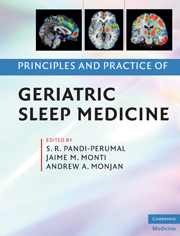Crossref Citations
This Book has been
cited by the following publications. This list is generated based on data provided by Crossref.
Lader, Malcolm
2015.
The Encyclopedia of Clinical Psychology.
p.
1.
Suh, Seung Wan
Han, Ji Won
Han, Ji Hyun
Bae, Jong Bin
Moon, Woori
Kim, Hye Sung
Oh, Dae Jong
Kwak, Kyung Phil
Kim, Bong Jo
Kim, Shin Gyeom
Kim, Jeong Lan
Kim, Tae Hui
Ryu, Seung-Ho
Moon, Seok Woo
Park, Joon Hyuk
Byun, Seonjeong
Seo, Jiyeong
Youn, Jong Chul
Lee, Dong Young
Lee, Dong Woo
Lee, Seok Bum
Lee, Jung Jae
Jhoo, Jin Hyeong
and
Kim, Ki Woong
2020.
Sex differences in subjective age-associated changes in sleep: a prospective elderly cohort study.
Aging,
Vol. 12,
Issue. 21,
p.
21942.
Fleiner, Tim
Trumpf, Rieke
Hollinger, Anna
Haussermann, Peter
and
Zijlstra, Wiebren
2021.
Quantifying Circadian Aspects of Mobility-Related Behavior in Older Adults by Body-Worn Sensors—An “Active Period Analysis”.
Sensors,
Vol. 21,
Issue. 6,
p.
2121.
Bharti, Vijay K.
Pandi-Perumal, Seithikurippu R.
and
Subramanian, Perumal
2023.
Sleep and Clocks in Aging and Longevity.
Vol. 18,
Issue. ,
p.
223.
Chen, Xuan
Zhang, Peng
Peng, Kaiping
and
Wang, Yifan
2025.
Life Activities Time Allocation and Subjective Well-Being of the Old Adults in China: a Compositional Perspective.
Applied Research in Quality of Life,



